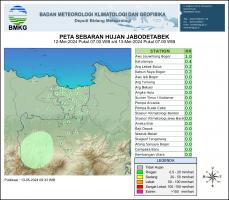| Current Cyclone | Cyclone Outlook | After Events Report | Historical Cyclone | Annual Reports | Cyclone Names | Learn About TC |
Is Indonesia tracked by tropical cyclone?
According to the climatology, Indonesia that lies on the equator is not tracked by tropical cyclone. Yet there are enough cyclones occurred around to change weather pattern over the area. For example, Cyclone Rossie (2008) which passed west of Banten, Kirrily (2009) that developed above Aru Islands, Inigo which passed Nusa Tenggara at its developing stage, and Vamei (2001), claimed as the closest to equator cyclone when it developed around Malaka Peninsula at 1.5°N.

Using tropical cyclone data for a period from 1964 to 2005 for South East Indian Ocean basin and from 1951 to 2006 for Western North Pasific basin, calculation has been carried out to describe cyclone occurance at area of near Indonesia especially from 90o to 150o E and from 30° S to 30° N.
South of Indonesia Cyclone
From historical data over a period of 42 years, it is known that majority of cyclone occurance at south of Indonesia is on February at 23%. It is 122 cyclones occurred, that means about three cyclones in average. On this month, the most peak year is in 1968 when 7 cyclones developed in this area. Though there were February 1867, 1990 and 2002 when there was no cyclone developed.
While December, as the second peak month of the period, there were 76 cyclones occurred, that means about 2 cyclones in average. Extreme event was experienced at December 1973 when 6 cyclones developed in a month.
However, almost no cyclone occurred on June and August.

North of Indonesia Cyclone
With longer historical data for 56 years, it is calculated that the most peak month at the area is August with 20% cyclone occurance, followed with September (18%), July and October (15%).
In august, when about 5 cyclones occurrence in average, maximum number of cyclone was experienced in 1960 when 13 cyclones occurred and minimum in 1980 when only 2 cyclones occurred. Contrarily, in February with the least cyclone occurance (only 13 cyclone in 56 years), 1967 and 1976 experience 2 cyclones, 9 other years with one cyclone, and 45 others none.
In August, the most peak month in this area, 107 from 323 cyclones are intensified to gained storm force wind, and 81 from those are developed to gained hurricane force wind.

Table of Contents
« Tropical Cyclone, Tropical Storm, Hurricane & Typhoon
Cyclone Impact »










